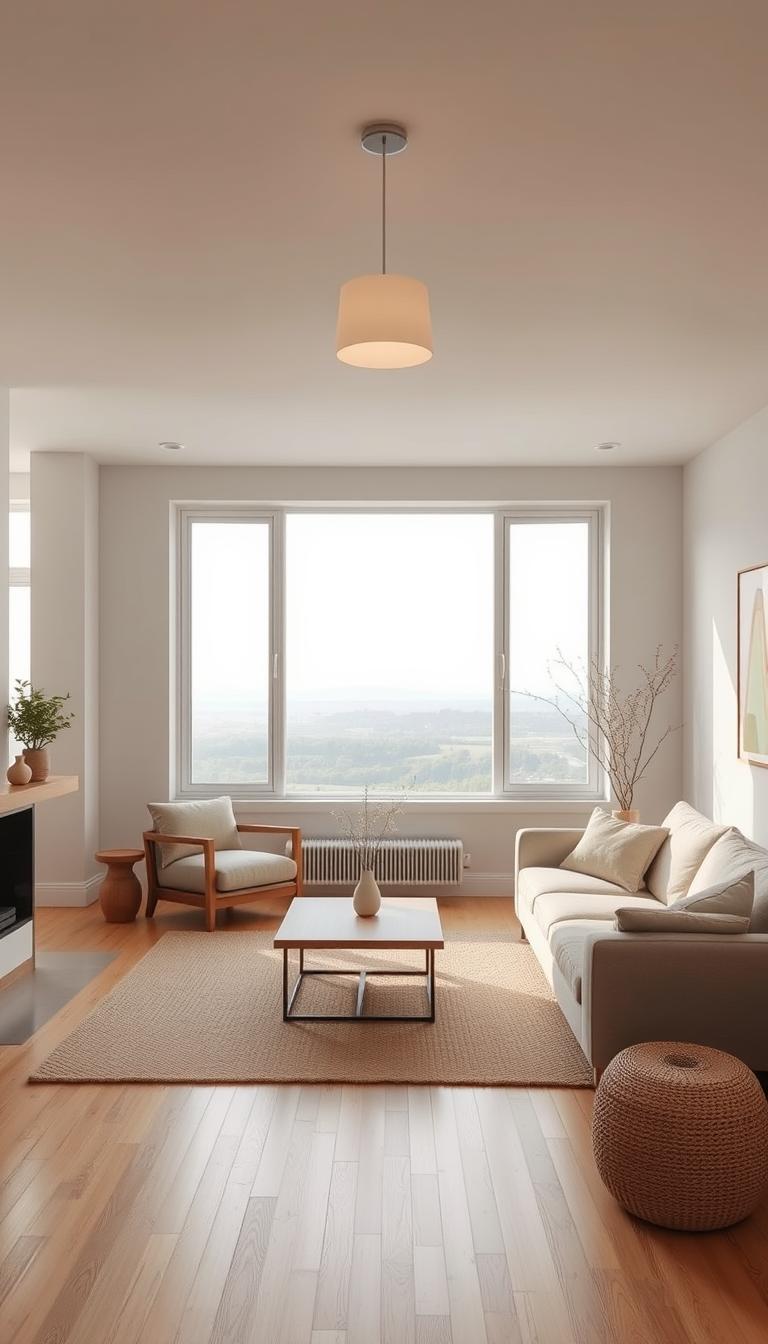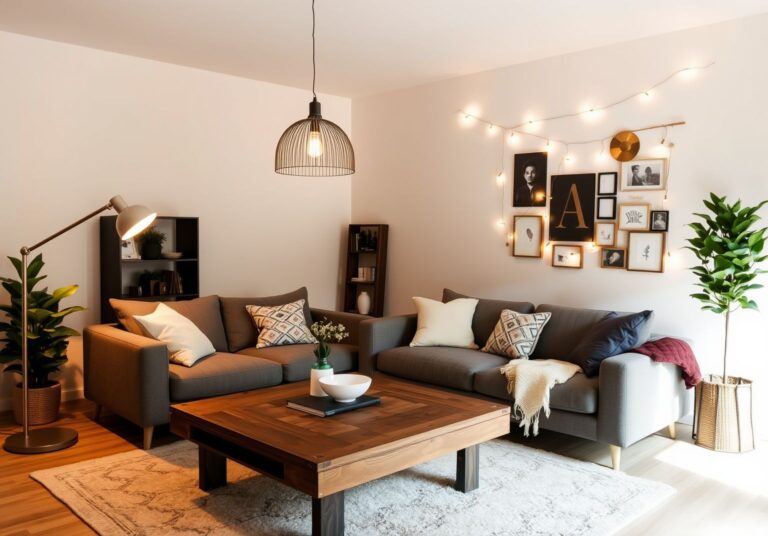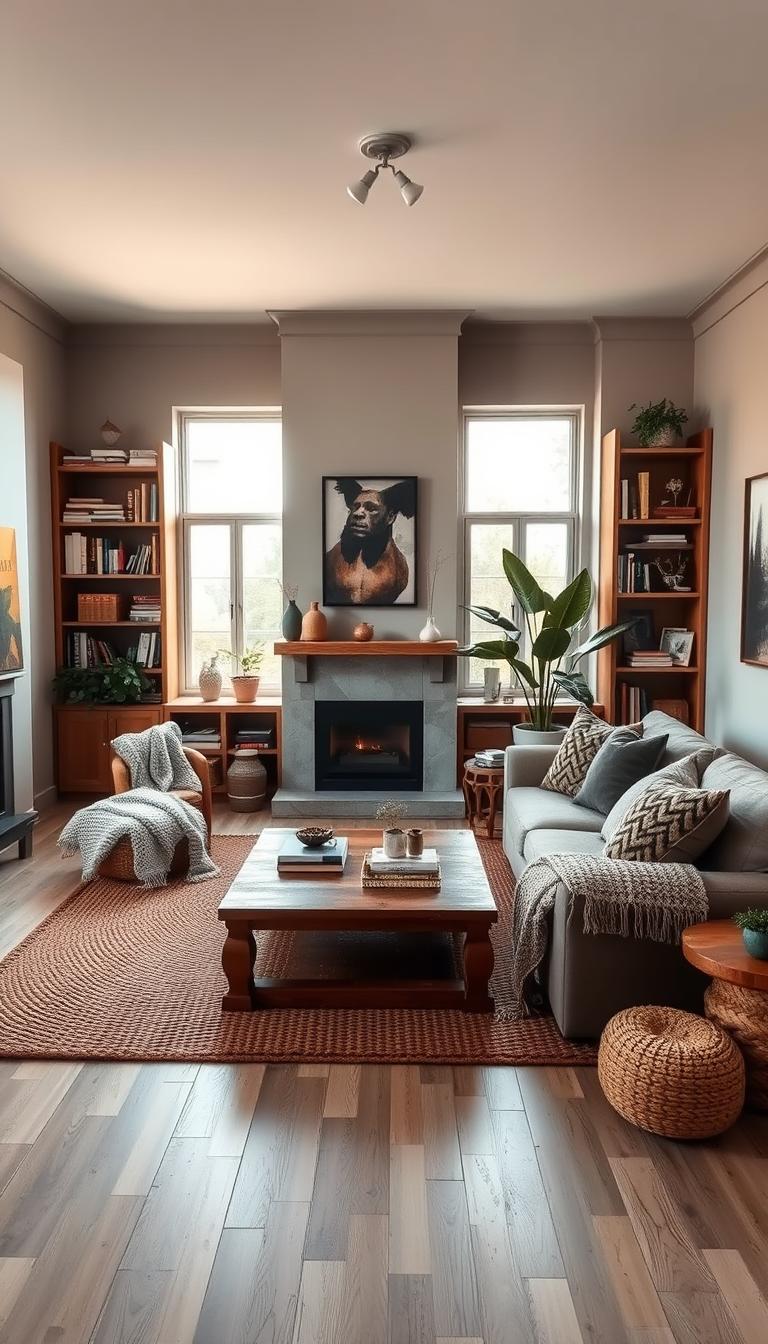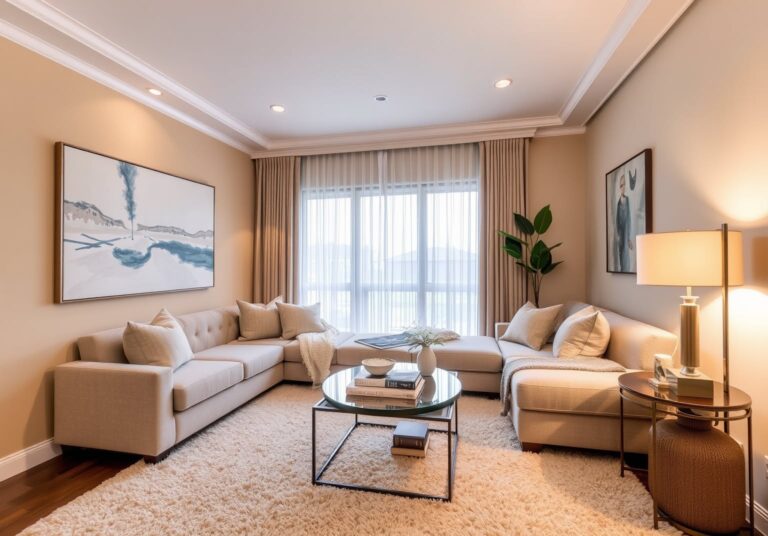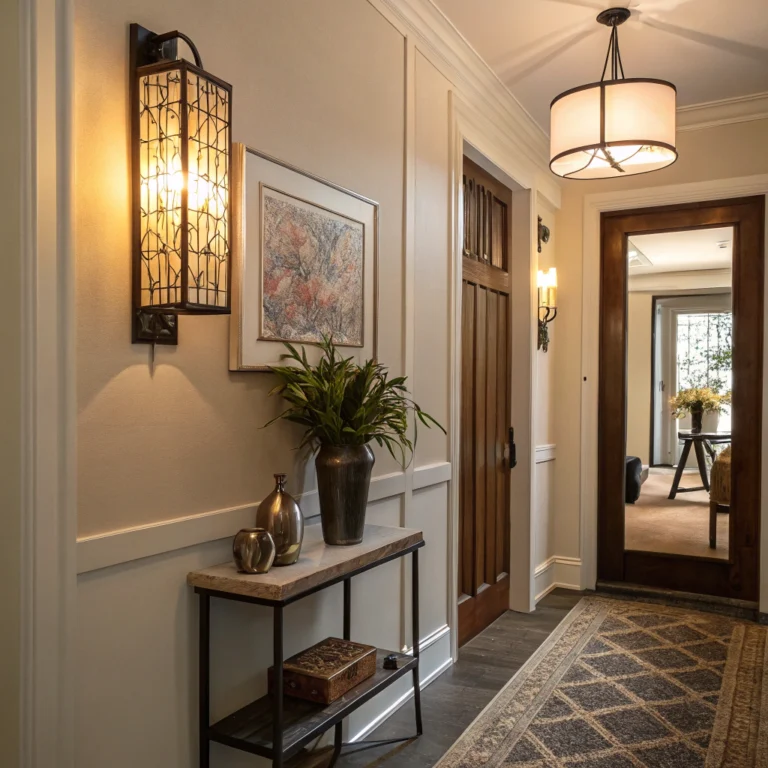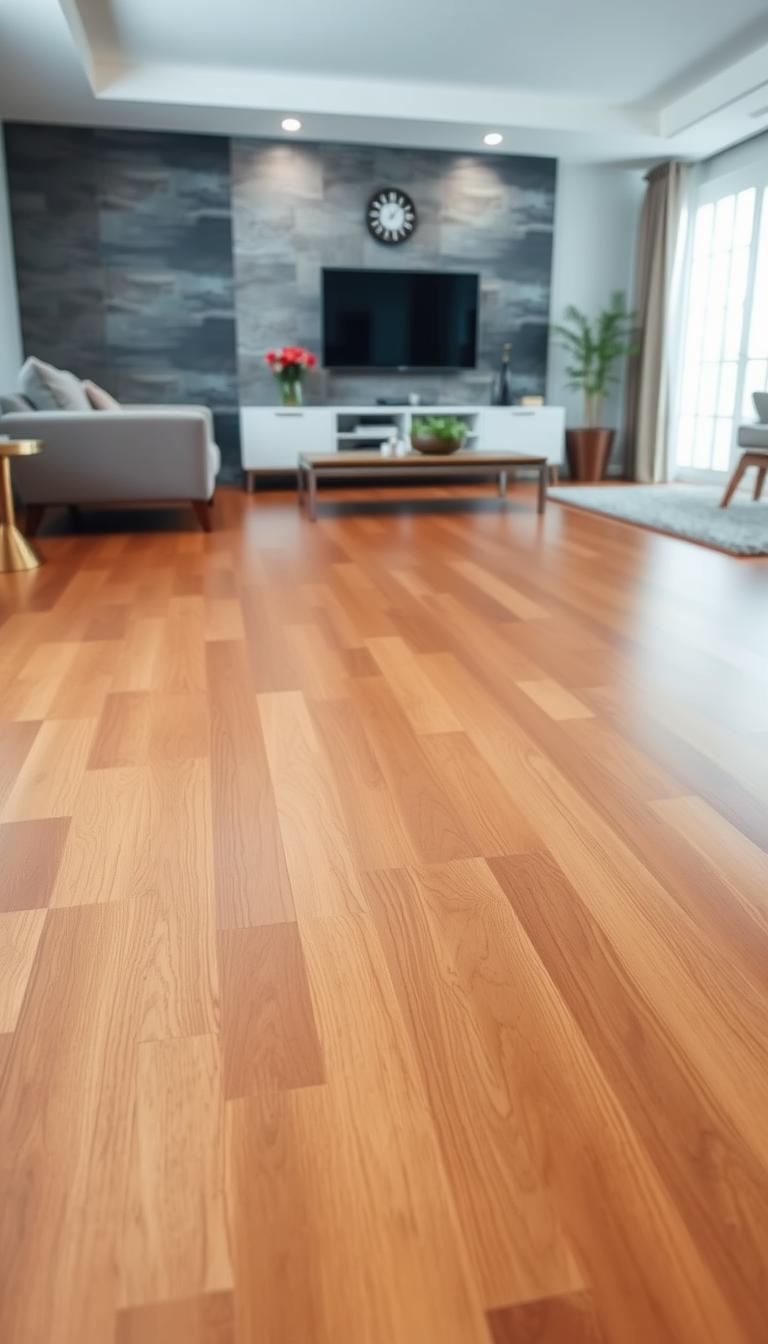Modern Minimalist Living Room Ideas for a Calming Space
Creating a serene atmosphere in your home is easier than you think. Minimalism, which originated in the mid-20th century, draws inspiration from Scandinavian design principles, focusing on simplicity, functionality, and a connection to nature.
A well-designed living room can become a peaceful sanctuary, promoting mental wellbeing by reducing visual noise and creating a sense of calm. By making thoughtful design choices, you can achieve a balance between style and functionality, proving that “less is more” without sacrificing comfort.
Discover how to transform your space into a serene retreat through strategic furniture placement, color selection, and intentional decor choices, making it perfect for busy lifestyles while maintaining a stylish look.
The Essence of Minimalist Design in Living Spaces
The essence of minimalist design lies in its ability to simplify and declutter living spaces. Minimalist interior design appeals to those who crave simplicity and a more sustainable lifestyle.
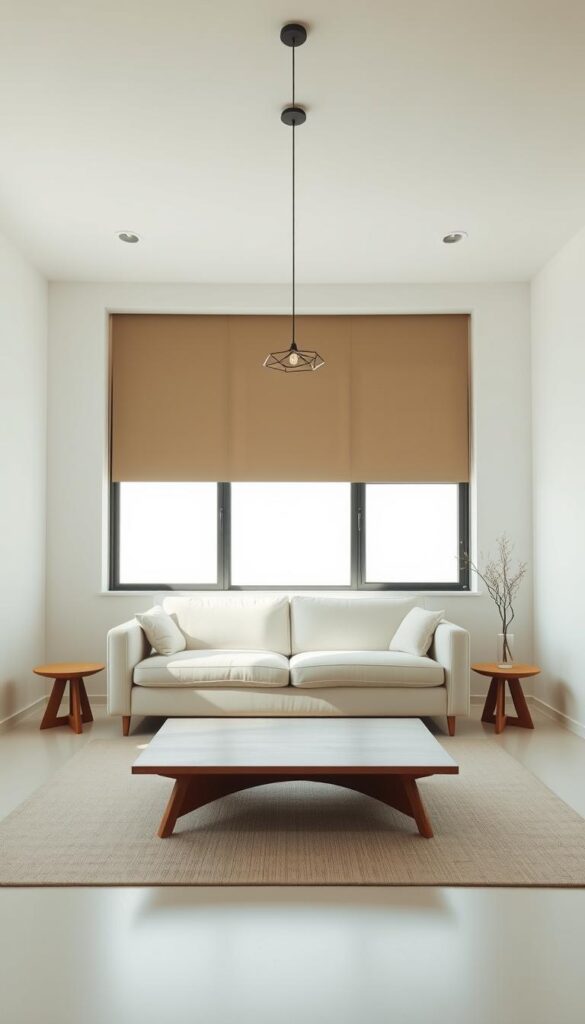
Minimalist design philosophy centers around the principle that “less is more,” focusing on quality over quantity and intentional choices rather than accumulation. This approach creates a sense of openness and visual harmony, making the living room a calming space.
- Prioritizes functionality, with each piece of furniture and decor serving a specific purpose.
- Creates visual harmony and a sense of order, promoting relaxation and mental clarity through clean lines.
- Has evolved to incorporate texture and subtle personality while maintaining simplicity.
- Often features open layouts that maximize flow and create a sense of spaciousness.
By embracing minimalist design, you can create a more sustainable lifestyle and a living room that is both calming and functional. The style emphasizes connection to nature, functionality, and simplicity, making it ideal for those seeking a serene living environment.
Creating a Neutral Color Foundation
A well-chosen neutral color palette is the backbone of a serene minimalist space. Neutral colors play a significant role in defining the aesthetic of a minimalist living room.
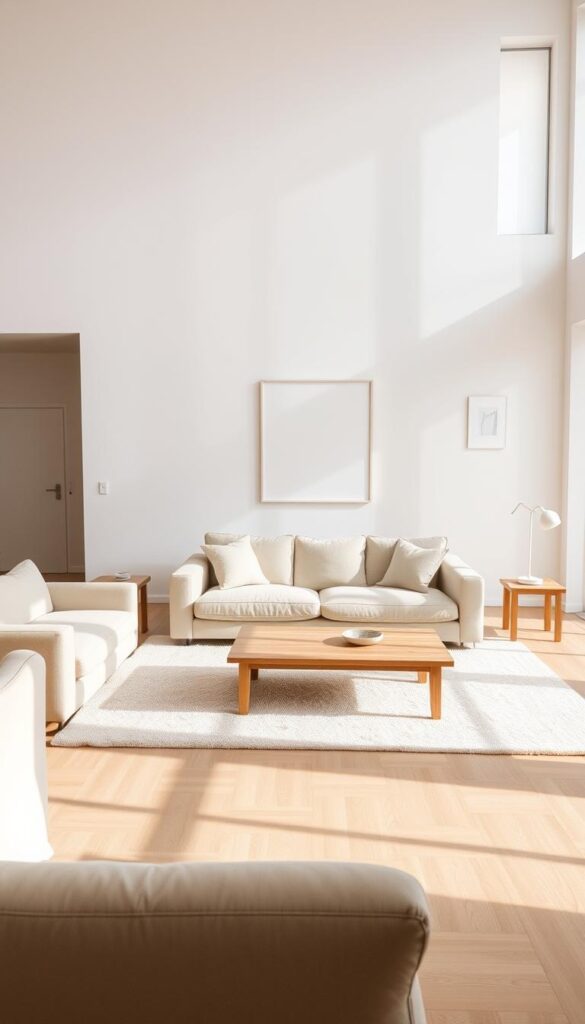
Neutral color palettes form the foundation of living room design, creating a calm canvas that allows architectural features and carefully selected furniture to shine. While white, beige, and gray are staples, soft, muted tones like sage green or blush pink can be incorporated as accent colors to add depth.
| Color Scheme | Effect on Room | Example Colors |
|---|---|---|
| Monochromatic | Creates depth and visual interest | Various shades of gray |
| Cooler Tones | More serene atmosphere | Light gray, pale blue |
| Warmer Neutrals | Makes a room feel cozier | Beige, cream |
By selecting the right neutral color foundation and considering the psychology of color, you can create a living room that feels larger and more open. Paying attention to lighting will also bring out the subtle undertones in your chosen neutrals, enhancing the overall color palette.
Maximizing Natural Light in Your Modern Minimalist Living Room
Embracing natural light is a crucial element in creating a modern minimalist living room that feels spacious and inviting. It instantly creates a bright, airy atmosphere that makes your space appear larger and more open.
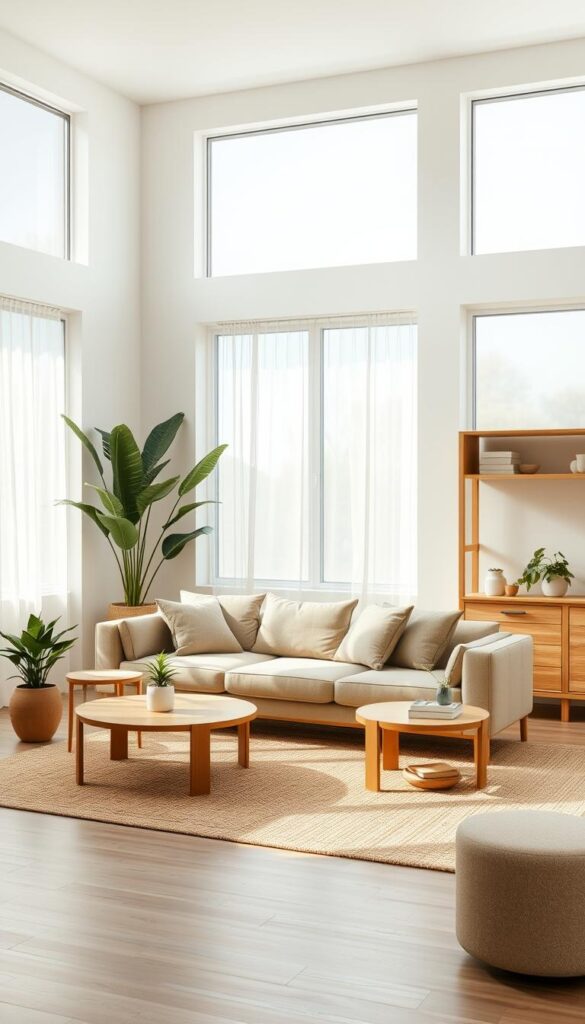
- Remove heavy window treatments or replace them with sheer, lightweight options to filter light without blocking it completely.
- Strategically place mirrors to amplify natural light by reflecting it throughout your living room.
- Position furniture to take advantage of natural light sources, avoiding blocking windows and considering the path sunlight takes through your room.
- Use light-colored walls, floors, and furniture to reflect rather than absorb light.
By implementing these strategies, you can create a bright and welcoming atmosphere in your modern minimalist living room.
Selecting Statement Furniture Pieces
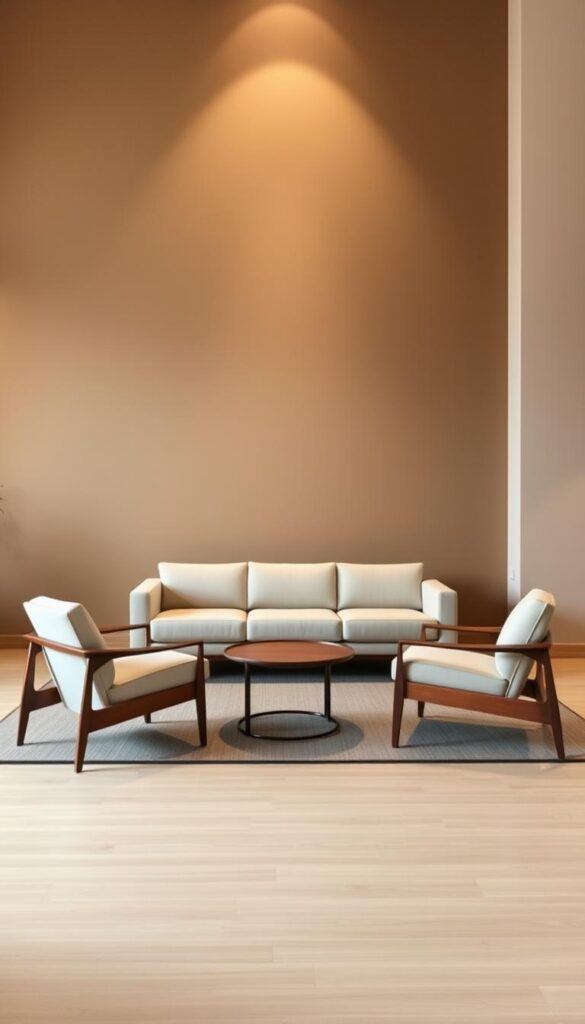
When curating a minimalist living room, the key to success lies in selecting statement furniture pieces that balance form and function. Minimalist design emphasizes quality over quantity, making it an ideal opportunity to invest in timeless items.
Statement furniture pieces in a minimalist living room should not only be aesthetically pleasing but also functional. For instance, a high-quality sofa with clean lines can serve as the room’s anchor.
| Furniture Piece | Functionality | Aesthetic Appeal |
|---|---|---|
| Sofa | Primary seating | Clean lines, timeless design |
| Coffee Table | Surface for decor and functionality | Simple, sculptural design |
| Chair | Additional seating | Uniquely designed, artisanal |
By thoughtfully selecting statement furniture pieces, you can create a harmonious and functional minimalist living room.
The Art of Negative Space
Negative space is not just the absence of furniture; it’s a deliberate design choice that significantly impacts the ambiance of your living room. In minimalist living room design, negative space refers to the empty areas between furniture and decor, creating visual breathing room that allows the eye to rest.
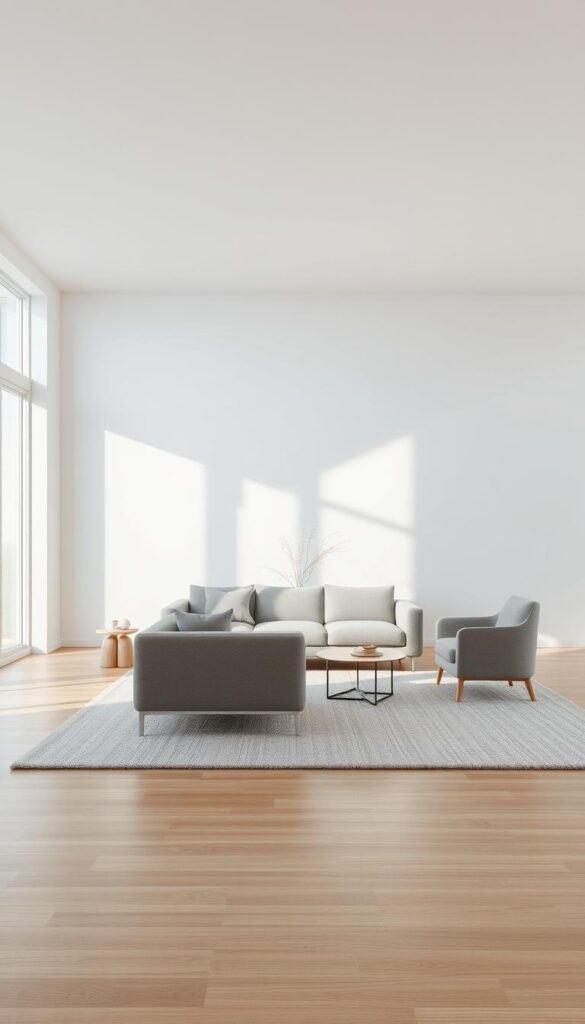
To effectively utilize negative space, start by removing items that don’t serve a purpose or bring joy. This approach helps maintain a calm atmosphere in the room. Strategic negative space highlights statement pieces, making them stand out rather than competing for attention. In smaller rooms, ample negative space can create the illusion of a larger area, enhancing the sense of space.
Regular curation is necessary to maintain the balance of negative space and prevent clutter from disrupting your minimalist living room design.
Incorporating Natural Elements and Textures
To add depth to a minimalist living room, it’s essential to incorporate natural elements and textures. With limited decor and a neutral color palette, it’s easy for minimalist designs to appear boring.
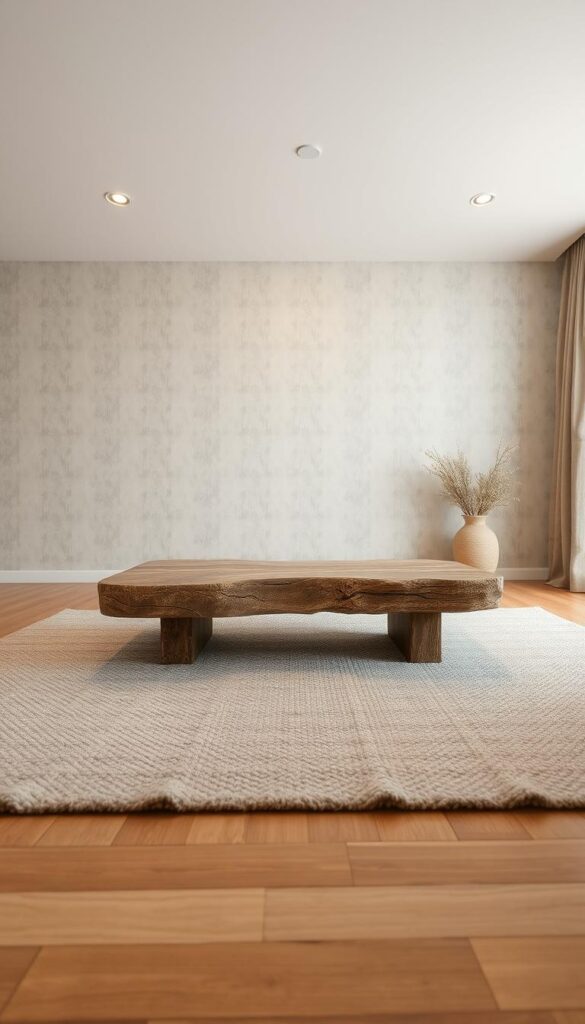
Embracing natural textures wherever possible can prevent this. For instance, wood, leather, and jute accents can lend texture to a neutral rug and linen sofa, creating an inviting, earthy quality.
Natural elements and varied textures prevent minimalist living rooms from feeling cold or sterile, adding warmth and dimension without introducing clutter. Layering different textures like smooth leather, nubby linen, soft wool, and rough stone creates tactile interest that engages the senses.
Indoor plants are also perfect additions, introducing life, color, and organic shapes while purifying the air and improving wellbeing. By incorporating elements from nature, you can create a connection to the outdoors that makes your minimalist living room feel more grounded and inviting.
Minimalist Storage Solutions
Storage solutions are the unsung heroes of minimalist living rooms, keeping essentials out of sight while maintaining a clean aesthetic.
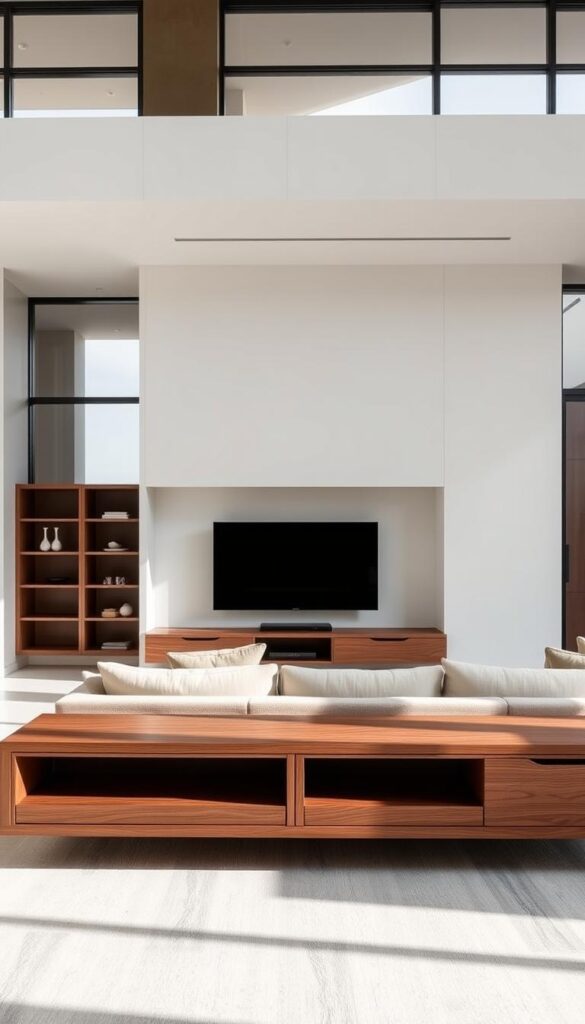
A living room needs to be a functional gathering place, no matter which decorating style you choose. If you have a lot of clutter, like electronic gadgets or kids’ toys, look for storage solutions that will keep everything accessible but out of sight.
- Effective storage is the unsung hero of successful minimalist living rooms, allowing you to maintain clean lines and open spaces while accommodating life’s necessities.
- Built-in storage solutions that blend seamlessly with walls create a streamlined look while maximizing functionality.
- Multi-functional furniture like storage ottomans and coffee tables with drawers provide practical storage without adding extra pieces to your room.
Some effective storage solutions include:
| Storage Solution | Description | Benefits |
|---|---|---|
| Built-in Storage | Floor-to-ceiling bookcases or under-window cabinets | Streamlined look, maximizes functionality |
| Multi-functional Furniture | Storage ottomans, sofas with hidden compartments, coffee tables with drawers | Practical storage, reduces clutter |
| Floating Shelves | Display space for curated items | Maintains open, airy feel |
Consider the “one in, one out” rule for maintaining your minimalist living room. Digital solutions can also reduce physical storage needs by digitizing media collections, documents, and photos.
Lighting Choices for a Serene Atmosphere
Creating a serene atmosphere in a minimalist living room heavily relies on thoughtful lighting design. Effective lighting can enhance the ambiance and highlight architectural features without introducing visual clutter.
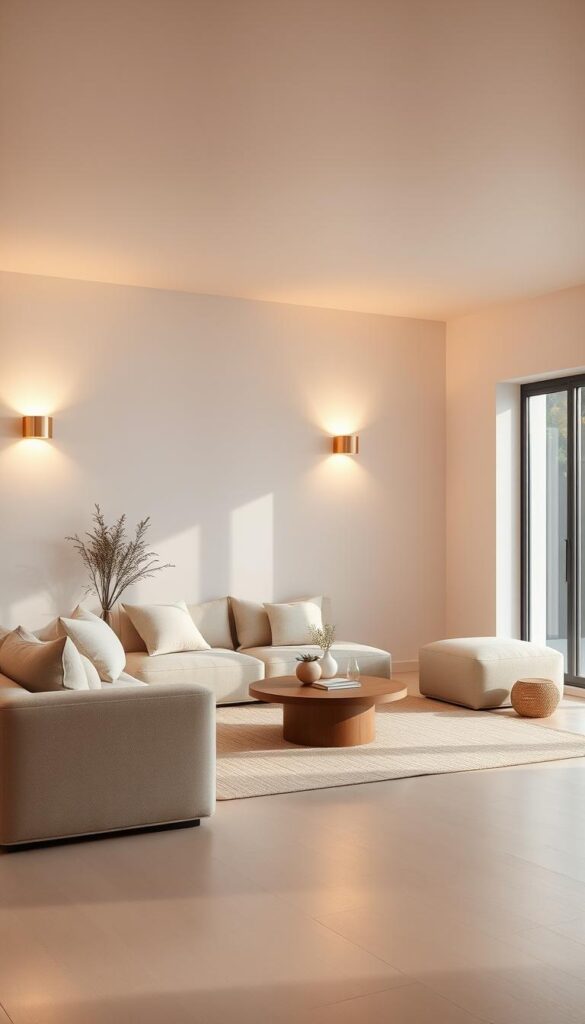
A sculptural chandelier can make a dramatic statement, visually increasing ceiling height and complementing modern design elements like concrete fireplaces and chic furniture.
- Layer different types of lighting—ambient, task, and accent—to create a flexible scheme.
- Statement light fixtures can add personality and visual interest while maintaining clean lines.
- Consider the quality of light; warm-toned bulbs create a cozier atmosphere than cool-toned options.
Recessed lighting and simple floor and table lamps contribute to a minimalist aesthetic, while smart lighting systems allow for control over brightness and color temperature, adapting to different needs and moods.
Wall Treatments in Minimalist Design
In minimalist design, wall treatments play a crucial role in creating a clean and calming living room. Paint exposed brick walls crisp white for a clean and uniform backdrop.

Continue the modern aesthetic with black window frames that contrast the white walls. Layer your monochrome space with plenty of textured neutrals to warm it up and bring in a tall floor plant to liven up the room.
- Simple wall treatments like crisp white or neutral tones create a clean backdrop that makes furniture and art stand out.
- Textural wall treatments like subtle plaster finishes or tone-on-tone wallpaper add dimension without overwhelming the space.
- Architectural details like simple molding or shiplap can add character to walls while maintaining clean lines.
By incorporating these wall treatment ideas, you can create a serene and calming atmosphere in your minimalist living room.
Thoughtful Decor Selection
The key to decorating a minimalist living room lies in choosing pieces that are both meaningful and aesthetically pleasing. A well-curated decor not only adds personality to the space but also maintains its serene atmosphere.
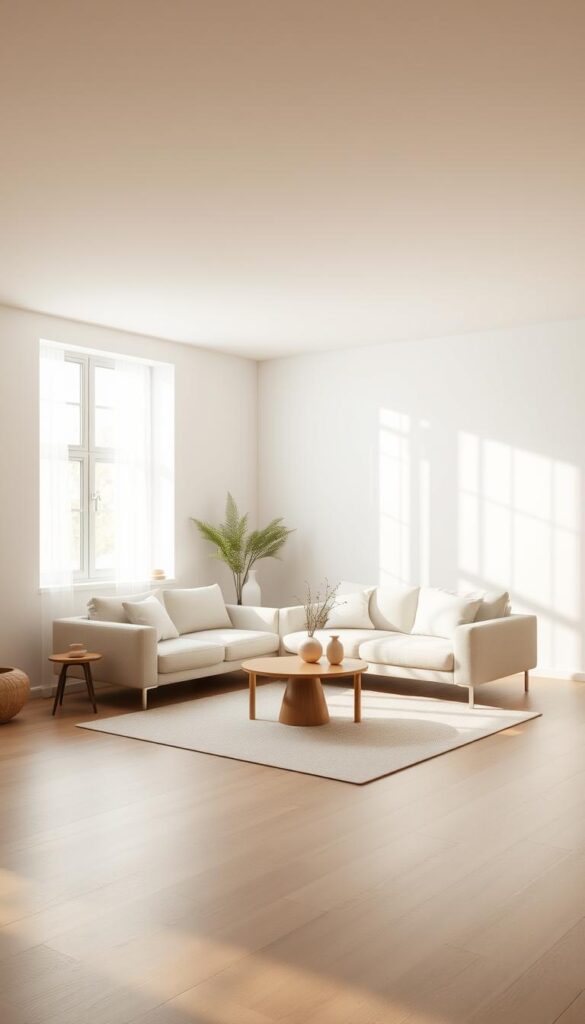
In a minimalist living room, a gallery wall can be a great way to add a personal touch, especially if you crave a little color. Consider three factors when assembling a gallery wall: artwork type, frame style, and size of the piece.
| Decor Element | Purpose | Examples |
|---|---|---|
| Artwork | Adds personality and style | Photographs, paintings, drawings |
| Natural Elements | Adds life and organic shapes | Single branch in a vase, bowl of stones, potted plant |
| Textiles | Adds warmth and comfort | Throw blanket, pillows in complementary textures |
When selecting decor, remember that quality over quantity is the guiding principle. Personal items that tell your story are essential in preventing the space from feeling like a showroom.
Monochromatic Living Room Designs
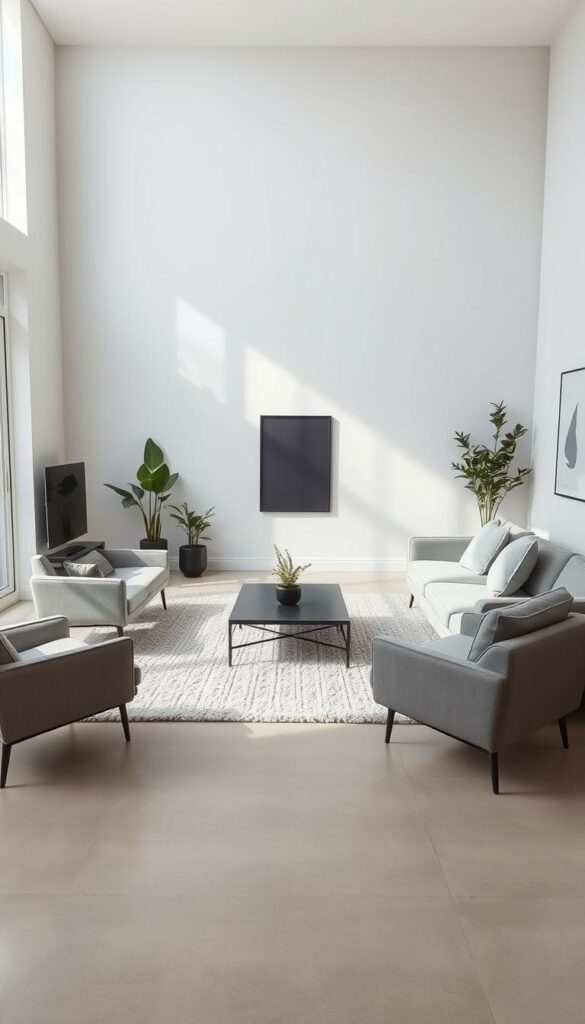
A monochromatic living room design is a masterclass in minimalism, where a single color palette creates visual harmony. This approach busts the myth that minimalist spaces have to be all white, allowing for the addition of color without clutter.
By opting for a single color with subtle variations, you can create a serene and inviting atmosphere. For instance, green wall paint can serve as a backdrop for green furniture, while small accents of warm yellow and gold add coziness.
| Benefits | Description |
|---|---|
| Visual Cohesion | Monochromatic color schemes create a unified look, perfect for minimalist living rooms. |
| Depth and Dimension | Incorporating lighter and darker versions of your chosen color adds depth. |
| Timeless Foundation | Neutral monochromatic schemes using whites, beiges, or grays are timeless and easily updated. |
Monochromatic rooms benefit from varied textures to prevent a flat feel. Natural light also interacts differently with various shades, creating subtle shifts throughout the day. The psychological effects of your chosen color should be considered, as different colors promote different feelings, such as calmness or comfort.
Mixing Materials for Visual Interest
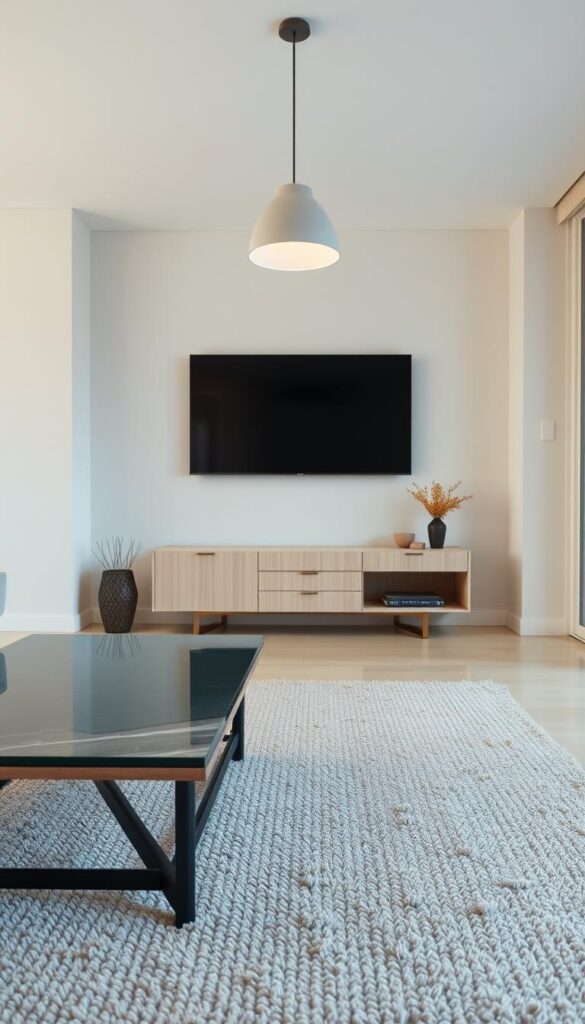
To prevent a minimalist living room from feeling flat, it’s essential to mix different materials thoughtfully. Minimalist living rooms typically include lots of solid surfaces, so incorporating various textures and materials can keep the space interesting.
A combination of soft and hard elements, such as a lush velvet sofa paired with a luxurious black marble coffee table, adds depth and visual interest. Natural materials like wood and stone bring warmth, while metal accents in brass or chrome add sophistication.
- Pair soft textiles with hard surfaces for contrast.
- Use natural materials to add warmth and authenticity.
- Consider the visual weight of materials to balance the space.
- Introduce metal accents sparingly for definition.
By thoughtfully mixing materials, you can create a visually appealing and balanced composition in your minimalist living room.
Creating Cozy Minimalist Spaces
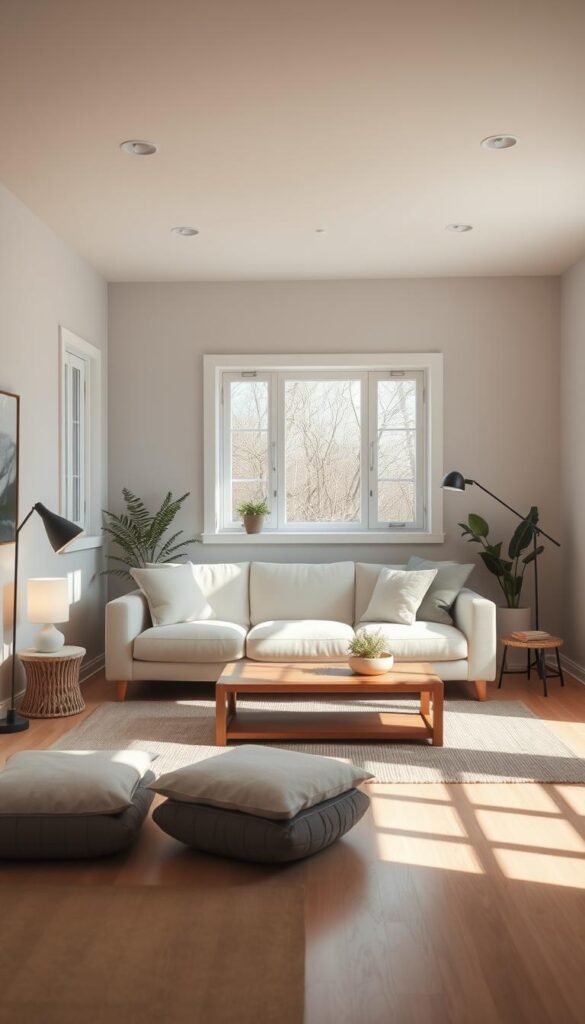
Cozy minimalism in living rooms is about striking the perfect balance between simplicity and warmth. To achieve this, consider incorporating elements that add both style and functionality.
For instance, a floating wood bench by the fireplace not only adds a touch of warmth but also provides storage for firewood. Accentuating the area with white shiplap and a decorative wall sconce can create a cozy nook.
| Element | Description | Benefit |
|---|---|---|
| Soft Textiles | Cashmere throws, wool rugs, linen or velvet upholstery | Invites touch and warmth |
| Layered Lighting | Overhead fixtures, floor lamps, table lamps, candles | Creates a warm, inviting glow |
| Natural Elements | Wood, plants, natural fibers | Adds warmth and life without clutter |
By thoughtfully incorporating these elements, you can create a minimalist living room that feels cozy and inviting, proving that minimalism doesn’t have to mean cold or sterile.
Open-Concept Minimalist Living Areas
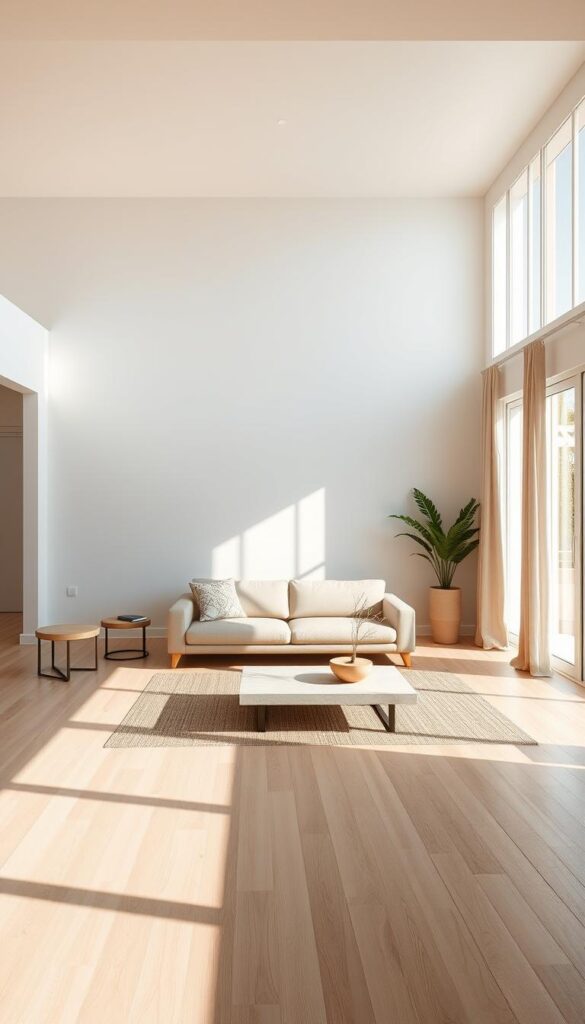
Open-concept living areas and minimalist design are a match made in heaven, as they both prioritize flow, spaciousness, and visual continuity. In open-concept minimalist spaces, furniture arrangement becomes crucial to create distinct zones for different activities while maintaining a cohesive overall design.
To achieve this, consider using area rugs to define separate functional areas within the room without disrupting the clean lines and flow of the space. Additionally, consider sight lines when designing open-concept minimalist areas—each vantage point should offer a pleasing, uncluttered view that draws the eye through the space.
- A consistent color palette throughout an open-concept area creates cohesion, while subtle variations in tone can help distinguish between functional zones.
- In larger open spaces, negative space becomes even more important—resist the urge to fill every area, allowing the architecture and carefully selected furniture to shine.
By incorporating these design principles, you can create a harmonious and functional open-concept minimalist living area that feels calm and serene.
Adding Personality While Maintaining Minimalism
A well-curated minimalist room can reflect your personality without clutter. The essence of minimalism lies in simplicity and the thoughtful selection of pieces that resonate with you.
To add personality, consider incorporating meaningful personal items. Family photographs, travel souvenirs, or inherited pieces can add soul to your minimalist living room when displayed thoughtfully.
| Method | Description | Example |
|---|---|---|
| Statement Piece | Add a bold or unique item | A boldly colored chair or an unusual light fixture |
| Book Collection | Display favorite titles | Simple floating shelves with spines facing out |
| Art Selections | Choose pieces that resonate personally | Artwork that reflects your personal style or interests |
| Mixing Styles | Combine different design styles | Pairing a traditional sofa with a modern armchair |
| Plants | Add greenery for life and character | Sculptural succulents or a statement tree |
By incorporating these elements, you can create a minimalist living room that not only looks serene but also feels personal and inviting.
Conclusion: Creating Your Own Calming Minimalist Living Room
The journey to a serene minimalist living room is a personal one, guided by universal design principles and individual preferences.
To create a calming space, start by decluttering and assessing what you truly need and love. This foundation of intentionality will guide your design decisions. Minimalism exists on a spectrum, and your version might include more color, texture, or personal items than someone else’s.
Investing in quality over quantity is key. Choose pieces that will stand the test of time both functionally and aesthetically. Consider how your minimalist living room will support your daily activities and routines. The true measure of success is how the space makes you feel, aiming for a space that promotes calm, clarity, and connection.
By thoughtfully applying the principles outlined in this guide, you can create a minimalist living room that feels both timeless and personal—a truly calming space to call your own.
